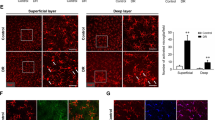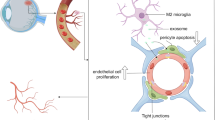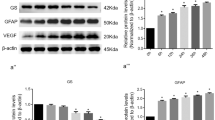Abstract
Diabetic retinopathy (DR) is recognized as the most prevalent retinal degenerative disorder. Inflammatory response usually precedes microvascular alteration and is the primary factor of diabetic retinopathy. Activated microglia express many pro-inflammatory cytokines that exacerbate retina inflammation and disruption. In the present study, we found that MSCs alleviated blood–retina barrier (BRB) breakdown in diabetic rats, as evidenced by reduced retinal edema, decreased vascular leakage, and increased occludin expression. The MSC-treated retinal microglia exhibited reduced expression of M1-phenotype markers in the diabetic rats, including inducible nitric oxide synthase (iNOS), CD16, and pro-inflammatory cytokines. On the other hand, MSCs increased the expression of M2-phenotype markers, such as arginase-1 (Arg-1), CD206, and anti-inflammatory cytokines. HMGB1/TLR4 signaling pathway is activated in DR and inhibited after MSC treatment. Consistent with in vivo evidence, MSCs drove BV2 microglia toward M2 phenotype in vitro. Overexpression of HMGB1 in microglia reversed the effects of MSC treatment, suggesting HMGB1/TLR4 pathway is necessary for MSCs’ regulatory effects on microglia polarization. Collectively, MSCs exert beneficial effects on DR by polarizing microglia from M1 toward M2 phenotype via inhibiting the HMGB1/TLR4 signaling pathway.








Similar content being viewed by others
Abbreviations
- MSCs:
-
Mesenchymal stem cells
- DR:
-
Diabetic retinopathy
- AGEs:
-
Advanced glycation end products
- BRB:
-
Blood–retina barrier
- HMGB1:
-
High mobility group box 1
- TLR4:
-
Toll-like receptor 4
- STZ:
-
Streptozotocin
- NFL:
-
Nerve fiber layer
- IPL:
-
Inner plexiform layer
- OPL:
-
Outer plexiform layer
- GCL:
-
Ganglion cell layer
- INL:
-
Inner nuclear layer
- ONL:
-
Outer nuclear layer
References
Nentwich, M.M., and M.W. Ulbig. 2015. Diabetic retinopathy - ocular complications of diabetes mellitus. World Journal of Diabetes 6 (3): 489–499.
Yau, J.W., S.L. Rogers, R. Kawasaki, E.L. Lamoureux, J.W. Kowalski, T. Bek, S.J. Chen, J.M. Dekker, A. Fletcher, J. Grauslund, S. Haffner, R.F. Hamman, M.K. Ikram, T. Kayama, B.E. Klein, R. Klein, S. Krishnaiah, K. Mayurasakorn, J.P. O’Hare, T.J. Orchard, M. Porta, M. Rema, M.S. Roy, T. Sharma, J. Shaw, H. Taylor, J.M. Tielsch, R. Varma, J.J. Wang, N. Wang, S. West, L. Xu, M. Yasuda, X. Zhang, P. Mitchell, T.Y. Wong, and G. Meta-analysis for eye disease study. 2012. Global prevalence and major risk factors of diabetic retinopathy. Diabetes Care 35 (3): 556–564.
Simo, R., C. Hernandez, and R. European Consortium for the Early Treatment of Diabetic. 2014. Neurodegeneration in the diabetic eye: New insights and therapeutic perspectives. Trends in Endocrinology and Metabolism 25 (1): 23–33.
Forrester, J.V., L. Kuffova, and M. Delibegovic. 2020. The role of inflammation in diabetic retinopathy. Frontiers in Immunology 11: 583687.
Vujosevic, S., and R. Simó. 2017. Local and systemic inflammatory biomarkers of diabetic retinopathy: an integrative approach. Invest Ophthalmol Vis Sci 58 (6): Bio68-bio75.
Singh, R., A. Barden, T. Mori, and L. Beilin. 2001. Advanced glycation end-products: A review. Diabetologia 44 (2): 129–146.
Ying, L., Y. Shen, Y. Zhang, Y. Wang, Y. Liu, J. Yin, Y. Wang, J. Yin, W. Zhu, Y. Bao, and J. Zhou. 2021. Association of advanced glycation end products with diabetic retinopathy in type 2 diabetes mellitus. Diabetes Research and Clinical Practice 177: 108880.
Stitt, A.W. 2010. AGEs and diabetic retinopathy. Investigative Ophthalmology & Visual Science 51 (10): 4867–4874.
Tao, D., N. Ni, T. Zhang, C. Li, Q. Sun, L. Wang, and Y. Mei. 2019. Accumulation of advanced glycation end products potentiate human retinal capillary endothelial cells mediated diabetic retinopathy. Molecular Medicine Reports 20 (4): 3719–3727.
Del Rio-Hortega Bereciartu, J. 2020. Pio del Rio-Hortega: The revolution of Glia. Anatomical Record (Hoboken) 303 (5): 1232–1241.
Li, F., D. Jiang, and M.A. Samuel. 2019. Microglia in the developing retina. Neural Development 14 (1): 12.
Karlstetter, M., R. Scholz, M. Rutar, W.T. Wong, J.M. Provis, and T. Langmann. 2015. Retinal microglia: Just bystander or target for therapy? Progress in Retinal and Eye Research 45: 30–57.
Sierra, A., F. de Castro, J. Del Río-Hortega, J. Rafael Iglesias-Rozas, M. Garrosa, and H. Kettenmann. 2016. The “Big-Bang” for modern glial biology: Translation and comments on Pío del Río-Hortega 1919 series of papers on microglia. Glia 64 (11): 1801–1840.
Orihuela, R., C.A. McPherson, and G.J. Harry. 2016. Microglial M1/M2 polarization and metabolic states. British Journal of Pharmacology 173 (4): 649–665.
Shi, H., X.L. Wang, H.F. Quan, L. Yan, X.Y. Pei, R. Wang, and X.D. Peng. 2019. Effects of betaine on LPS-stimulated activation of microglial M1/M2 phenotypes by suppressing TLR4/NF-kappaB pathways in N9 cells. Molecules 24 (2).
Moutray, T., J.R. Evans, N. Lois, D.J. Armstrong, T. Peto, and A. Azuara-Blanco. 2018. Different lasers and techniques for proliferative diabetic retinopathy. Cochrane Database Syst Rev 3 (3): Cd012314.
Zhao, M., Y. Sun, and Y. Jiang. 2020. Anti-VEGF therapy is not a magic bullet for diabetic retinopathy. Eye (London, England) 34 (4): 609–610.
Shi, M., Z.W. Liu, and F.S. Wang. 2011. Immunomodulatory properties and therapeutic application of mesenchymal stem cells. Clinical and Experimental Immunology 164 (1): 1–8.
Shi, Y., Y. Wang, Q. Li, K. Liu, J. Hou, C. Shao, and Y. Wang. 2018. Immunoregulatory mechanisms of mesenchymal stem and stromal cells in inflammatory diseases. Nature Reviews Nephrology 14 (8): 493–507.
Kode, J.A., S. Mukherjee, M.V. Joglekar, and A.A. Hardikar. 2009. Mesenchymal stem cells: Immunobiology and role in immunomodulation and tissue regeneration. Cytotherapy 11 (4): 377–391.
Song, H.B., S.Y. Park, J.H. Ko, J.W. Park, C.H. Yoon, D.H. Kim, J.H. Kim, M.K. Kim, R.H. Lee, D.J. Prockop, and J.Y. Oh. 2018. Mesenchymal stromal cells inhibit inflammatory lymphangiogenesis in the cornea by suppressing macrophage in a TSG-6-dependent manner. Molecular Therapy 26 (1): 162–172.
Agrawal, M., P.K. Rasiah, A. Bajwa, J. Rajasingh, and R. Gangaraju. 2021. Mesenchymal stem cell induced Foxp3(+) Tregs suppress effector T cells and protect against retinal ischemic injury. Cells 10 (11).
Andersson, U., H. Yang, and H. Harris. 2018. High-mobility group box 1 protein (HMGB1) operates as an alarmin outside as well as inside cells. Seminars in Immunology 38: 40–48.
Dai, W., T. Tang, Z. Dai, D. Shi, L. Mo, and Y. Zhang. 2020. Probing the mechanism of hepatotoxicity of hexabromocyclododecanes through toxicological network analysis. Environmental Science and Technology 54 (23): 15235–15245.
Pourrajab, F., M.B. Yazdi, M.B. Zarch, M.B. Zarch, and S. Hekmatimoghaddam. 2015. Cross talk of the first-line defense TLRs with PI3K/Akt pathway, in preconditioning therapeutic approach. Mol Cell Ther 3: 4.
Mendiola, A.S., R. Garza, S.M. Cardona, S.A. Mythen, S.A. Lira, K. Akassoglou, and A.E. Cardona. 2016. Fractalkine signaling attenuates perivascular clustering of microglia and fibrinogen leakage during systemic inflammation in mouse models of diabetic retinopathy. Frontiers in Cellular Neuroscience 10: 303.
van Hecke, M.V., J.M. Dekker, G. Nijpels, A.C. Moll, R.J. Heine, L.M. Bouter, B.C. Polak, and C.D. Stehouwer. 2005. Inflammation and endothelial dysfunction are associated with retinopathy: The Hoorn Study. Diabetologia 48 (7): 1300–1306.
Joussen, A.M., T. Murata, A. Tsujikawa, B. Kirchhof, S.E. Bursell, and A.P. Adamis. 2001. Leukocyte-mediated endothelial cell injury and death in the diabetic retina. American Journal of Pathology 158 (1): 147–152.
Yun, J.H., S.W. Park, K.J. Kim, J.S. Bae, E.H. Lee, S.H. Paek, S.U. Kim, S. Ye, J.H. Kim, and C.H. Cho. 2017. Endothelial STAT3 activation increases vascular leakage through downregulating tight junction proteins: Implications for diabetic retinopathy. Journal of Cellular Physiology 232 (5): 1123–1134.
Li, S., R. Hua, Z. Jing, L. Huang, and L. Chen. 2022. Correlation between retinal microstructure detected by optical coherence tomography and best corrected visual acuity in diabetic retinopathy macular edema. Front Endocrinol (Lausanne) 13: 831909.
Yu, C., K. Yang, X. Meng, B. Cao, and F. Wang. 2020. Downregulation of long noncoding RNA MIAT in the retina of diabetic rats with tail-vein injection of human umbilical-cord mesenchymal stem cells. International Journal of Medical Sciences 17 (5): 591–598.
van Velthoven, C.T., R.A. Sheldon, A. Kavelaars, N. Derugin, Z.S. Vexler, H.L. Willemen, M. Maas, C.J. Heijnen, and D.M. Ferriero. 2013. Mesenchymal stem cell transplantation attenuates brain injury after neonatal stroke. Stroke 44 (5): 1426–1432.
Tan, T.T., W.S. Toh, R.C. Lai, and S.K. Lim. 2022. Practical considerations in transforming MSC therapy for neurological diseases from cell to EV. Experimental Neurology 349: 113953.
Regmi, S., S. Pathak, J.O. Kim, C.S. Yong, and J.H. Jeong. 2019. Mesenchymal stem cell therapy for the treatment of inflammatory diseases: Challenges, opportunities, and future perspectives. European Journal of Cell Biology 98 (5–8): 151041.
Alvarado-Velez, M., S.F. Enam, N. Mehta, J.G. Lyon, M.C. LaPlaca, and R.V. Bellamkonda. 2021. Immuno-suppressive hydrogels enhance allogeneic MSC survival after transplantation in the injured brain. Biomaterials 266: 120419.
Ransohoff, R.M. 2016. A polarizing question: Do M1 and M2 microglia exist? Nature Neuroscience 19 (8): 987–991.
Paolicelli, R.C., A. Sierra, B. Stevens, M.E. Tremblay, A. Aguzzi, B. Ajami, I. Amit, E. Audinat, I. Bechmann, M. Bennett, F. Bennett, A. Bessis, K. Biber, S. Bilbo, M. Blurton-Jones, E. Boddeke, D. Brites, B. Brone, G.C. Brown, O. Butovsky, M.J. Carson, B. Castellano, M. Colonna, S.A. Cowley, C. Cunningham, D. Davalos, P.L. De Jager, B. de Strooper, A. Denes, B.J.L. Eggen, U. Eyo, E. Galea, S. Garel, F. Ginhoux, C.K. Glass, O. Gokce, D. Gomez-Nicola, B. Gonzalez, S. Gordon, M.B. Graeber, A.D. Greenhalgh, P. Gressens, M. Greter, D.H. Gutmann, C. Haass, M.T. Heneka, F.L. Heppner, S. Hong, D.A. Hume, S. Jung, H. Kettenmann, J. Kipnis, R. Koyama, G. Lemke, M. Lynch, A. Majewska, M. Malcangio, T. Malm, R. Mancuso, T. Masuda, M. Matteoli, B.W. McColl, V.E. Miron, A.V. Molofsky, M. Monje, E. Mracsko, A. Nadjar, J.J. Neher, U. Neniskyte, H. Neumann, M. Noda, B. Peng, F. Peri, V.H. Perry, P.G. Popovich, C. Pridans, J. Priller, M. Prinz, D. Ragozzino, R.M. Ransohoff, M.W. Salter, A. Schaefer, D.P. Schafer, M. Schwartz, M. Simons, C.J. Smith, W.J. Streit, T.L. Tay, L.H. Tsai, A. Verkhratsky, R. von Bernhardi, H. Wake, V. Wittamer, S.A. Wolf, L.J. Wu, and T. Wyss-Coray. 2022. Microglia states and nomenclature: A field at its crossroads. Neuron 110 (21): 3458–3483.
Ronaldson, P.T., and T.P. Davis. 2020. Regulation of blood-brain barrier integrity by microglia in health and disease: a therapeutic opportunity. J Cereb Blood Flow Metab 40 (1_suppl): S6-S24.
Zindel, J., and P. Kubes. 2020. DAMPs, PAMPs, and LAMPs in immunity and sterile inflammation. Annual Review of Pathology: Mechanisms of Disease 15: 493–518.
Fu, Y.J., B. Xu, S.W. Huang, X. Luo, X.L. Deng, S. Luo, C. Liu, Q. Wang, J.Y. Chen, and L. Zhou. 2021. Baicalin prevents LPS-induced activation of TLR4/NF-kappaB p65 pathway and inflammation in mice via inhibiting the expression of CD14. Acta Pharmacologica Sinica 42 (1): 88–96.
Schultze, S.M., B.A. Hemmings, M. Niessen, and O. Tschopp. 2012. PI3K/AKT, MAPK and AMPK signalling: Protein kinases in glucose homeostasis. Expert Reviews in Molecular Medicine 14: e1.
Li, Q., W. Wu, D. Gong, R. Shang, J. Wang, and H. Yu. 2021. Propionibacterium acnes overabundance in gastric cancer promote M2 polarization of macrophages via a TLR4/PI3K/Akt signaling. Gastric Cancer 24 (6): 1242–1253.
Xu, S., J. Wang, J. Jiang, J. Song, W. Zhu, F. Zhang, M. Shao, H. Xu, X. Ma, and F. Lyu. 2020. TLR4 promotes microglial pyroptosis via lncRNA-F630028O10Rik by activating PI3K/AKT pathway after spinal cord injury. Cell Death & Disease 11 (8): 693.
Hua, F., T. Ha, J. Ma, Y. Li, J. Kelley, X. Gao, I.W. Browder, R.L. Kao, D.L. Williams, and C. Li. 2007. Protection against myocardial ischemia/reperfusion injury in TLR4-deficient mice is mediated through a phosphoinositide 3-kinase-dependent mechanism. The Journal of Immunology 178 (11): 7317–7324.
Funding
This work was supported by the National Natural Science Foundation of China (NSFC) (grant nos. 81970062 and 81770061 to GY).
Author information
Authors and Affiliations
Contributions
TJ and CY contributed to collection of data, data analysis, and interpretation. TJ, XH, and ZX performed the whole experimental work. TJ contributed to manuscript writing. YG, SL, and XZ contributed to conception and design, financial support, and final approval of the manuscript. The authors read and approved the final manuscript.
Corresponding authors
Ethics declarations
Competing Interests
The authors declare no competing interests.
Additional information
Publisher's Note
Springer Nature remains neutral with regard to jurisdictional claims in published maps and institutional affiliations.
Supplementary Information
Below is the link to the electronic supplementary material.
Rights and permissions
Springer Nature or its licensor (e.g. a society or other partner) holds exclusive rights to this article under a publishing agreement with the author(s) or other rightsholder(s); author self-archiving of the accepted manuscript version of this article is solely governed by the terms of such publishing agreement and applicable law.
About this article
Cite this article
Tong, J., Yao, G., Chen, Y. et al. Mesenchymal Stem Cells Regulate Microglial Polarization via Inhibition of the HMGB1/TLR4 Signaling Pathway in Diabetic Retinopathy. Inflammation (2024). https://doi.org/10.1007/s10753-024-02005-6
Received:
Revised:
Accepted:
Published:
DOI: https://doi.org/10.1007/s10753-024-02005-6




